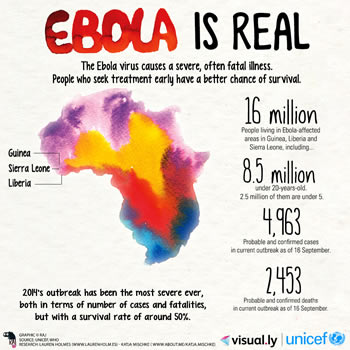Difference between Ebola virus and HIV virus
Key Difference: Both originated in Africa, and are carried by host animals. The Ebola virus directly attack any and all cell that it come in to contact with, whereas the HIV virus does not attack any cell, but instead disables the immune system allowing other infections to take root.
 While cases of Ebola have been documented for as long back as 1976, its outbreak has been limited. Its first outbreak was in 1976 in Sudan and Democratic Republic of the Congo. Following sporadic outbreaks, its biggest outbreak to date occurred in 2014 in West Africa. After this outbreak and the widespread panic that it created, Ebola was compared to the HIV virus by many people.
While cases of Ebola have been documented for as long back as 1976, its outbreak has been limited. Its first outbreak was in 1976 in Sudan and Democratic Republic of the Congo. Following sporadic outbreaks, its biggest outbreak to date occurred in 2014 in West Africa. After this outbreak and the widespread panic that it created, Ebola was compared to the HIV virus by many people. 
|
|
Ebola virus |
HIV virus |
|
Related Illnesses |
Ebola virus disease (EVD), Ebola hemorrhagic fever (EHF) |
Acquired Immunodeficiency Syndrome (AIDS) |
|
Causes |
A severe and often fatal hemorrhagic fever in humans and other mammals, known as Ebola virus disease (EVD). |
A condition in humans in which progressive failure of the immune system allows life-threatening opportunistic infections and cancers to thrive. |
|
Virology |
A virus of the family Filoviridae, genus Ebolavirus.
Five types of viruses:
|
A lentivirus; subgroup of retrovirus.
Two main types of viruses:
|
|
First Discovered |
In 1976 near the Ebola River in what is now the Democratic Republic of the Congo |
First clinically observed in 1981 in the United States. However dates back to 1920s in what is now the Democratic Republic of the Congo. |
|
Natural Hosts |
Fruit bats of the Pteropodidae family |
HIV-1 is related to viruses found in chimpanzees and gorillas living in western Africa, while HIV-2 viruses are related to viruses found in the endangered west African primate sooty mangabey. |
|
Transmission |
|
|
|
Incubation period (the time interval from infection with the virus to onset of symptoms) |
2 to 21 days. Cannot spread the |
Up to 10 years. |
|
Mode of Action |
Ebola physically destroys every cell it comes into contact with. |
HIV does not kill directly. It disables the immune system, allowing for the invasion of other diseases. |
|
Mutation Ability |
Does not mutate rapidly. Is fairly consistent. |
HIV virus mutates rapidly, which gives it a high genetic variability, |
|
Symptoms |
Fever, fatigue, muscle pain, headache and sore throat. Followed by vomiting, diarrhea, rash, symptoms of impaired kidney and liver function, and in some cases, both internal and external bleeding. |
There are three main stages of HIV infection: acute infection, clinical latency and AIDS.
|
|
Diagnosis |
Confirmation is made using the following investigations:
|
Confirmation is made using an enzyme-linked immunosorbent assay (ELISA) to detect antibodies to HIV-1.
If positive, it is followed by Western blot or, less commonly, an immunofluorescence assay (IFA).
Only considered HIV positive if both tests are positive. |
|
Treatment |
Rehydration with oral or intravenous fluids- and treatment of specific symptoms, improves rate of survival. |
Treatment consists of high active antiretroviral therapy (HAART) which slows progression of the disease. Treatment also includes preventive and active treatment of opportunistic infections. |
|
Survival time without treatment |
Typically six to sixteen days after symptoms appear and is often due to low blood pressure from fluid loss. |
Without treatment, average survival time after infection with HIV is estimated to be 9 to 11 years, depending on the HIV subtype. |
Image Courtesy: ebolastories.wordpress.com
Image Courtesy: aids.gov









Add new comment